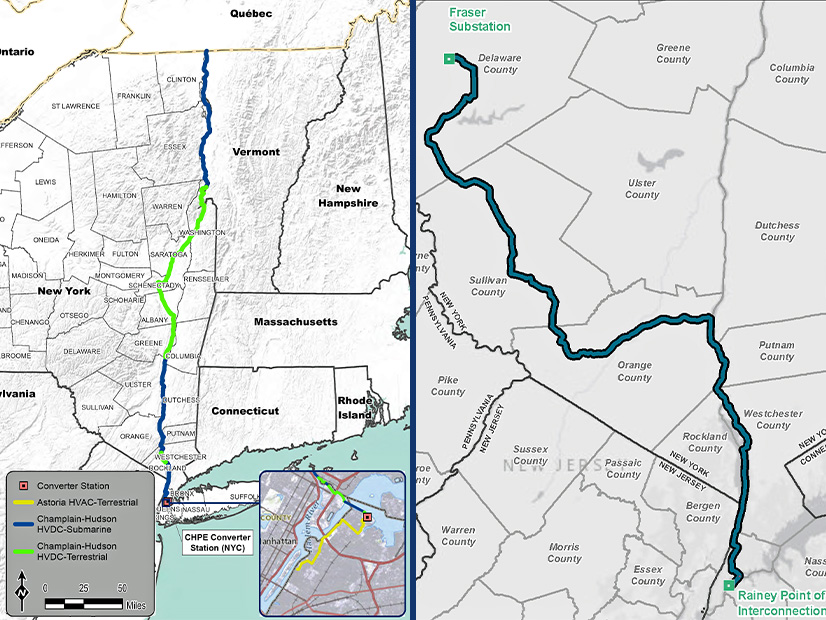
New York’s clean energy agency needs more time to draw up the renewable energy certificate program for two major renewable energy transmission projects.
The New York State Energy Research and Development Authority needs more time to draw up the renewable energy certificate program for two major transmission projects.
The agency on Wednesday asked the state Department of Public Service for a one-year extension of the deadline to create the Tier 4 REC implementation plan.
The Public Service Commission on April 14, 2022, approved contracts for Champlain Hudson Power Express and Clean Path New York and gave NYSERDA 180 days to draft the implementation plan for RECs for those projects (15-E-0302). A few days short of the deadline in October 2022, NYSERDA asked for a one-year extension because of the complexity of the issues, and DPS granted it.
A few days short of the deadline this month, NYSERDA is asking for another 12 months, again citing the complexity of the task before it, the newness of the concepts, the number of factors beyond its direct control and the sheer number of stakeholders collaborating on the effort.
NYSERDA lists seven focus points in its most recent letter, compared with only six last year:
-
- reviewing Tier 1 and Tier 4 shared resources contract alignment;
- assessing Tier 4 requirements for delivery verification, contract compliance and conformity with existing processes;
- evaluating systematic functionality that may be required in the New York Generation Attribute Tracking System and other enterprise systems for REC accounting, verification and settlement;
- preparing Supplier Greenhouse Gas Baseline accounting standards;
- assessing methods to verify demand response savings;
- establishing voluntary Tier 4 REC sales and settlement processes; and
- monitoring NYISO rulemaking relevant to internal controllable line operations and imported generation.
In its request, NYSERDA points out the two Tier 4 projects are not expected to come online until 2026 and 2027, which allows time for thoughtful and considered planning.
Champlain Hudson is a 340-mile underground/underwater HVDC line under construction that would import electricity from Quebec hydropower plants. Clean Path is an $11 billion suite that includes 1,800 MW of new solar generation, 2,000 MW of new wind power and a 175-mile underground HVDC line.
Both projects are intended to bring emissions-free electricity to New York City, where mandated retirements of fossil-fueled generation are setting up a potential reliability margin deficit as soon as 2025.
NYSERDA’s request comes as inflation and interest rate hikes roil the entire financial structure of renewable energy development in New York.
In June, developers with contracts for 4.23 GW of offshore wind nameplate capacity — 97% of the state’s offshore pipeline — told the DPS they might not be able to move forward without substantially higher offshore wind RECs. Developers of 91 onshore projects totaling 13.5 GW made the same case to DPS. Collectively the projects are a critical component of New York’s statutory goal of achieving 70% renewable power by 2030.
In late August, NYSERDA told the PSC it endorses some form of inflation adjustments as necessary to carry out the clean energy transition in New York.
As this was unfolding, Champlain Hudson and Clean Path made their own requests to the PSC. Clean Path in June wrote that it needed to be included in any inflation adjustments for Tier 1 RECs, as all 23 generation projects in its portfolio hold Tier 1 RECs or are eligible for them.
Champlain Hudson in August wrote that basic issues of fairness dictated it get the same increases granted to any other project, as its costs have increased just like theirs.
The PSC has not ruled on any of these requests yet.
Tier 4 is approaching its third birthday: The PSC created it on Oct. 15, 2020, through an order modifying the Clean Energy Standard. NYSERDA’s Tier 4 REC solicitation yielded 33 bids from seven sources. Clean Path and Champlain Hudson were ranked first and second, respectively, among the responses.
The two projects are predicted to reduce greenhouse gas emissions by 77 million metric tons over 15 years. The first-year impact on ratepayer bills has been estimated as an increase of 3 to 5.7% per month.


